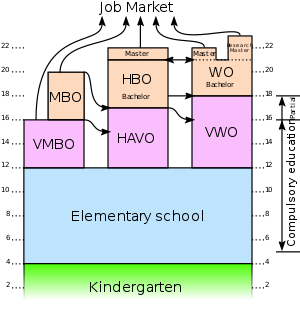Education in the Netherlands
 |
|
| Minister of Education | Jet Bussemaker |
|---|---|
| Budget | €32,1 billion ($42 billion) |
| Primary languages | Dutch Bilingual/Trilingual (with English, German, French or West Frisian (only in the northern part of the Netherlands) |
| Current system | 1968 (Mammoetwet). 1999 (latest revision). |
| Total | over 1200 students |
| Primary | 400 |
| Secondary | 300 |
| Post secondary | 300 |
Education in the Netherlands is characterized by division: education is oriented toward the needs and background of the pupil. Education is divided over schools for different age groups, some of which are divided in streams for different educational levels. Schools are furthermore divided in public, special (religious), and general-special (neutral) schools, although there are also a few private schools. The Dutch grading scale runs from 1 (very poor) to 10 (outstanding).
The Programme for International Student Assessment (PISA), coordinated by the Organization for Economic Co-operation and Development (OECD), ranks the education in the Netherlands as the 9th best in the world as of 2008, being significantly higher than the OECD average.
Educational policy is coordinated by the Dutch Ministry of Education, Culture and Science with municipal governments.
Compulsory education (leerplicht) in the Netherlands starts at the age of five, although in practice, most schools accept children from the age of four. From the age of sixteen there is a partial compulsory education (partiële leerplicht), meaning a pupil must attend some form of education for at least two days a week. Compulsory education ends for pupils aged eighteen and up or when they get a diploma on the VWO, HAVO or MBO level.
Public, special (religious), and general-special (neutral) schools are government-financed, receiving equal financial support from the government if certain criteria are met. Although they are officially free of charge, these schools may ask for a parental contribution (ouderbijdrage). Private schools rely on their own funds, but they are highly uncommon in the Netherlands, to the extent that even the Dutch monarchs have traditionally attended special or public schools. Public schools are controlled by local governments. Special schools are controlled by a school board and are typically based on a particular religion; those that assume equality between religions are known as general-special schools. These differences are present in all levels of education.
...
Wikipedia
